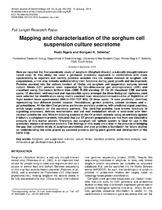| dc.description.abstract | Here we reported the first secretomic study of sorghum (Sorghum bicolor), a naturally drought tolerant cereal crop. In this study, we used a gel-based proteomic approach in combination with mass spectrometry to separate and identify proteins secreted into the culture medium of sorghum cell suspensions, a first step towards understanding their functions during plant growth and development. Proteins secreted into the culture medium of 10-day old sorghum cell suspension cultures termed culture filtrate (CF) proteins were separated by two-dimensional gel electrophoresis (2DE) and visualised using Coomassie brilliant blue (CBB) R-250 staining. Of the 25 visualised CBB stainable spots, 15 abundant, well-resolved and reproducible spots amongst the three biological replicates used were selected for identification using matrix assisted laser desorption/ionisation-time of flight/time of flight tandem mass spectrometry (MALDI-TOF-TOF MS). Of these spots, 14 were positively identified, representing four different protein classes: Peroxidases, germin proteins, oxalate oxidases and ?-galactosidases. All the identified proteins are known secretory proteins, with predicted signal peptides, which target proteins for the secretory pathway. The identified proteins have known functions in signalling processes, defence mechanisms and cell wall metabolism which is consistent with their location outside the cell. Western blotting analysis of the CF protein extracts using an antibody against ?-tubulin, a cytoplasmic protein, indicated that our CF protein preparations are free from any detectable amounts of this marker protein. Therefore, our sorghum cell culture system is ideal for use in the proteomic analysis of secreted proteins. The findings of this study are a step in the process of bridging the gap that currently exists in sorghum proteomics and also provides a foundation for future studies on understanding the roles played by secreted proteins during plant growth and development of the same crop. | en_US |

